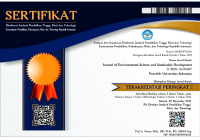Abstract
In Indonesia, urban litter is threatening the role of urban lakes as a part of green infrastructures in cities. To overcome this issue, Kenanga Lake—an urban lake with a surface area of 2.8 ha located within the Universitas Indonesia Campus—has been equipped with a trash trap unit on its inlet. However, the large amount of litter and its unpredictable pattern have made trash trap management difficult. The previous study illustrated the conceptual diagram of this problem. As a continuation in terms of looking further for sustainable solutions to this problem, this study aimed to establish its quantitative dynamic model, which is expressed as the mathematical equations of the interrelations among elements. We developed the model using the system dynamics modeling method with the Powersim Studio 10 software and validated it using the Average Mean Error (AME) method. To help calibrate the model, several supporting methods, i.e., field observation, load–weight analysis continuous sampling, and Theory of Planned Behavior (TPB)-based questionnaire survey, were used. Results showed that, on a sunny day, the maximum inlet lake litter load is 33 g/m3/h. Meanwhile, if rain falls, the maximum inlet lake litter load increases tenfold and reaches 346 g/m3/h. Then, the survey found that 22% of the citizens living in the location have a strong intention to dump their waste into the waterway. Moreover, the model has been validated, with the AME value of 0.1079 or confidence level of 89.21%. Finally, we conclude that the TPB-based questionnaire survey method can be combined with the system dynamics modeling method to capture the human sociocultural aspect of the system quantitatively. The applied methods can be used to solve the typical litter abundance problem in other urban lakes.
Recommended Citation
Muhsin, Muhammad and Soeryantono, Herr
(2019).
A QUANTITATIVE DYNAMIC MODEL FOR MANAGING LITTER ABUNDANCE IN THE TRASH TRAP OF AN URBAN LAKE IN INDONESIA.
Journal of Environmental Science and Sustainable Development, 2(1), 97-116.
Available at: https://doi.org/10.7454/jessd.v2i1.31






